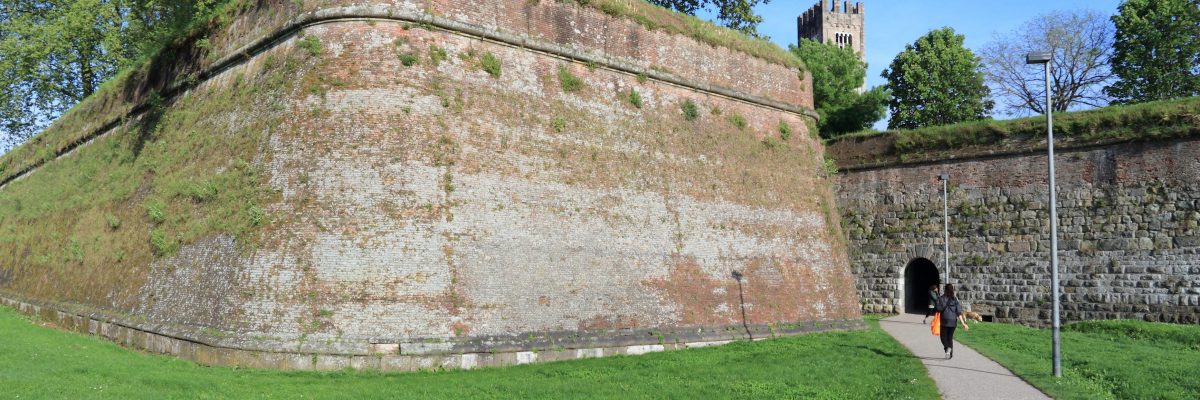
I’m in Lucca, the walled city.
I arrived yesterday afternoon from Florence. From the train station it was a fifteen-minute walk to my hotel, the San Luca Palace, located within the walled historical center near the westernmost gates, Porta Sant’Anna and Porta San Donato. The hotel is one of the nicest I’ve seen in Italy: an elegant breakfast room, fine parquet flooring along the hallways, and everything new and clean. My room is oversized, with a shower so large I can turn without knocking my elbows into the sides (unusual for Europe). The room costs $118 per night, a real bargain in a popular tourist area.
Last night there was no rain and, almost, no dinner. I got recommendations from the man at the desk and headed out early for the most likely restaurant. “A table for one, please.” “Mi dispiace, Signore, but we’re all booked.” I had neglected to make a reservation. I hadn’t counted on Lucca having many visitors this time of year. I learned only later tonight, from the woman sitting next to me at the concert, that La Buca di Sant’Antonio is the best restaurant in Lucca. No wonder there was no room at the inn.
As I left the restaurant, the passegiata started. The medieval streets were crowded, chiefly with young people strolling on a Saturday night, but also with tourists. What must Lucca be like in June? I ended up at an out-of-the-way osteria, which was nearly empty when I arrived but was packed by the time I finished.
Lucca is famed for its immense wall. It’s the third in the city’s history. First came the Roman wall, 2,150 feet long on the north and south, 1,750 feet long on the east and west, making about 90 acres in all, eventually accommodating 10,000 people. The medieval walls, irregularly formed around the first walls, doubled the area.
The Renaissance walls—the only ones to be seen today—enlarged the city to 270 acres. These walls are the same height as the Roman walls—23 feet—but are 100 feet wide at the base and 60 feet wide at the top. They are earthen but faced with brick. They were constructed on such a massive scale in order to foil attacks by Renaissance cannons. Just as the walls were completed, they became unnecessary, as the frequent wars between Tuscan cities came to an end.
In the nineteenth century the old walls of Florence were torn down, and boulevards were put in their places. No such architectural crime has been committed at Lucca: it would be too much trouble to move the mountain’s-worth of earth. The stones that formed Florence’s walls could be reused in new construction, but what could one do with the dirt that forms Lucca’s walls? The walls are now a great promenade along which, in good weather, locals and visitors go walking and biking.
But not today. The persistent rain and chill keep all but the hardiest off the walls. This afternoon I ventured up for a quick look and heard a loudspeaker on the far side. Finding a vantage point, I saw in the distance the starting place of what seemed to be a marathon. The runners probably would make good times, I thought, just in an effort to keep warm.
Lucca has forty-one churches within its walls. On this Sunday only six of them have Masses, one Mass per church. I attended the 10:30 a.m. at San Michele in Foro, commonly mistaken for the cathedral because it’s located in the center of town, has a magnificent façade (that from the rear looks like a stage set), and is featured on postcards.
The interior of San Michele is at once satisfying and disappointing. It features several fine statues and a few even finer paintings, including one by Filippino Lippi. Done on wood, this picture has been in the church since the early 1500s and shows Sts. Roch, Sebastian, Jerome, and Helena, each iconographically correct.
The elegance of the artworks contrasts with the barrenness of the walls and ceiling, which look unfinished. The walls are built of rectangular blocks of smoothed stone; if they all were the same size, they would be mistaken for modern cinder blocks. They seem to be crying for a thick coat of plaster.
Like the more influential Florence, Lucca matured in the Renaissance, so you might think its liturgies even today would be finely done. You would be wrong. Like most of Italy, here the Mass seems to be caught in amber—not the amber of the 1470s but the amber of the 1970s. Music was by guitar, though, weirdly, at the offertory the organ played, and then the guitar played over the organ. (Don’t try this at home—please.)
In the procession the priest was led by nine altar servers, all around age twelve. There was one boy. The other eight were girls. None of the kids had the slightest idea what to do, and none of them seem to have been introduced to genuflection.
During Mass three servers were at either side of the priest, and the other three were off to the left in a side pew. They all had to be directed where to go and what to do. The eight-to-one female-male ratio made me suspect that this diocese has few priestly vocations, which commonly spring from boys having experience as acolytes. Why would boys of twelve want to be around so many girls? I suspected that this lone boy participated only because his sister was an altar server and his mother was insistent.
This afternoon I made dinner reservations for tonight and tomorrow night, and then, after cleaning up at the hotel, went to a concert. The featured pieces were “La Tiranna” by Boccherini and the “Quintet for Strings” by Schubert. The musicians were the Quartetto Noûs, young performers who played the Boccherini, and French cellist Alain Meunier, who joined the four for the Schubert.
I arrived when the auditorium was almost full and had to hunt for a seat. “É libero qui?” I asked an elderly woman sitting on an aisle seat. She got up to let me in, and I sat down beside her. After a few minutes I asked her when this church had been turned into an auditorium, and I discovered she spoke excellent English, with a British accent. She volunteered that she was Milanese but had lived in Lucca for fifty years—actually, outside the walls, somewhere in the midst of olive trees.
She said she was particularly interested in how the cellos would handle the Schubert piece, which, she said, is perhaps his most vibrant, if played properly. From her comments about music and from the way she held herself, I surmised that she was someone of note. We didn’t introduce ourselves, and it’s unlikely I would have recognized her name anyway, but I wouldn’t be surprised if she was of noble lineage.
In any case, she was a delight to speak with and, at the end, applauded heartily and said “Bravo!” more than once. (She was too refined to shout it.) I leaned over and asked for her evaluation of the performers. She gave her benediction: “All they lacked is maturity,” referring to Quartetto Noûs. There was no need to say anything about Meunier, whose playing was spectacular.
At breakfast at the hotel I had met a British couple from Liverpool. Like me, they will be in Lucca for four days. I envied them their closeness to Italy. They can come and go almost at will and for short visits. Americans, particularly those on the West Coast, have to allot at least two weeks for a European visit. Anything shorter is inefficient, since two days are used for getting there and back, and another day is shot with recovering from jet lag.
Brian and Ruth told me that, back home, they had been enjoying a television series based on Andrea Camilleri’s detective Commissario Montalbano. “A fine coincidence,” I said. Yesterday I was in the Mondadori book store, just a few minutes’ walk from the San Luca Palace, and bought a copy of Un Mese con Montalbano (A Month with Montalbano), a collection of thirty short stories, one for each day of the month.
If the rain continues, I will be spending more time in the hotel than I had planned. No matter. There are worse things to do than reading whodunnits in an ancient walled city.



